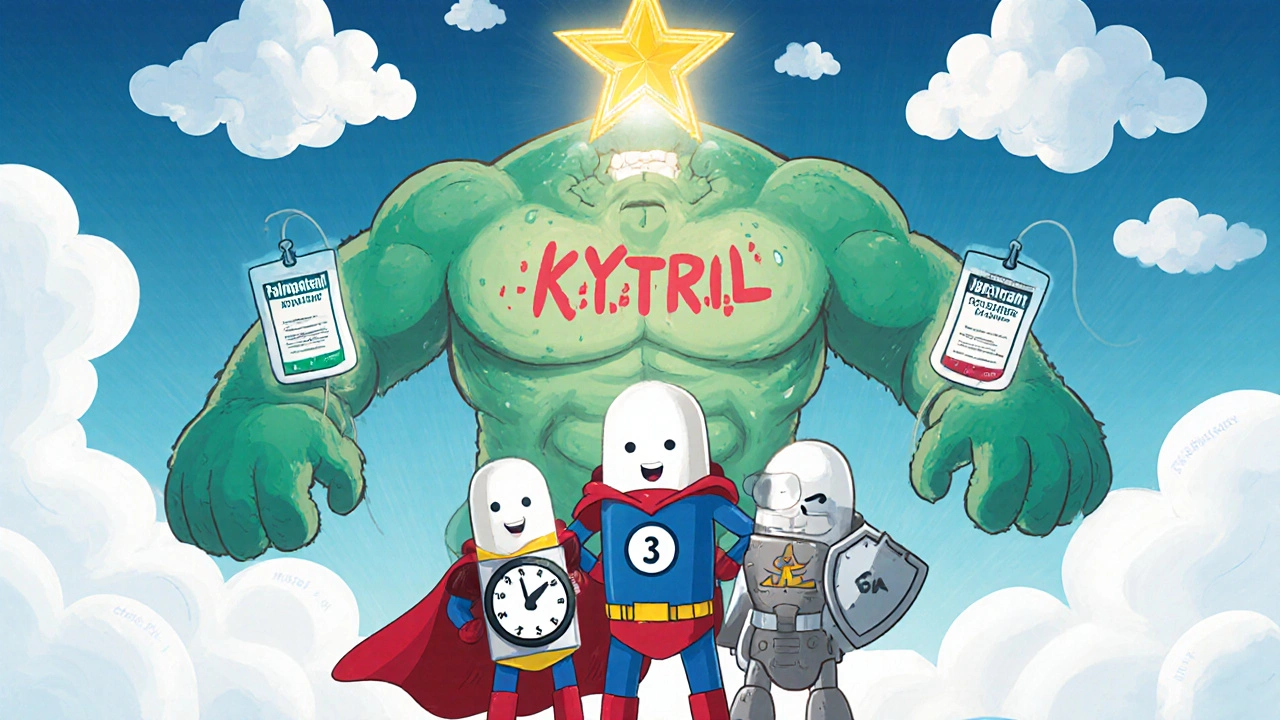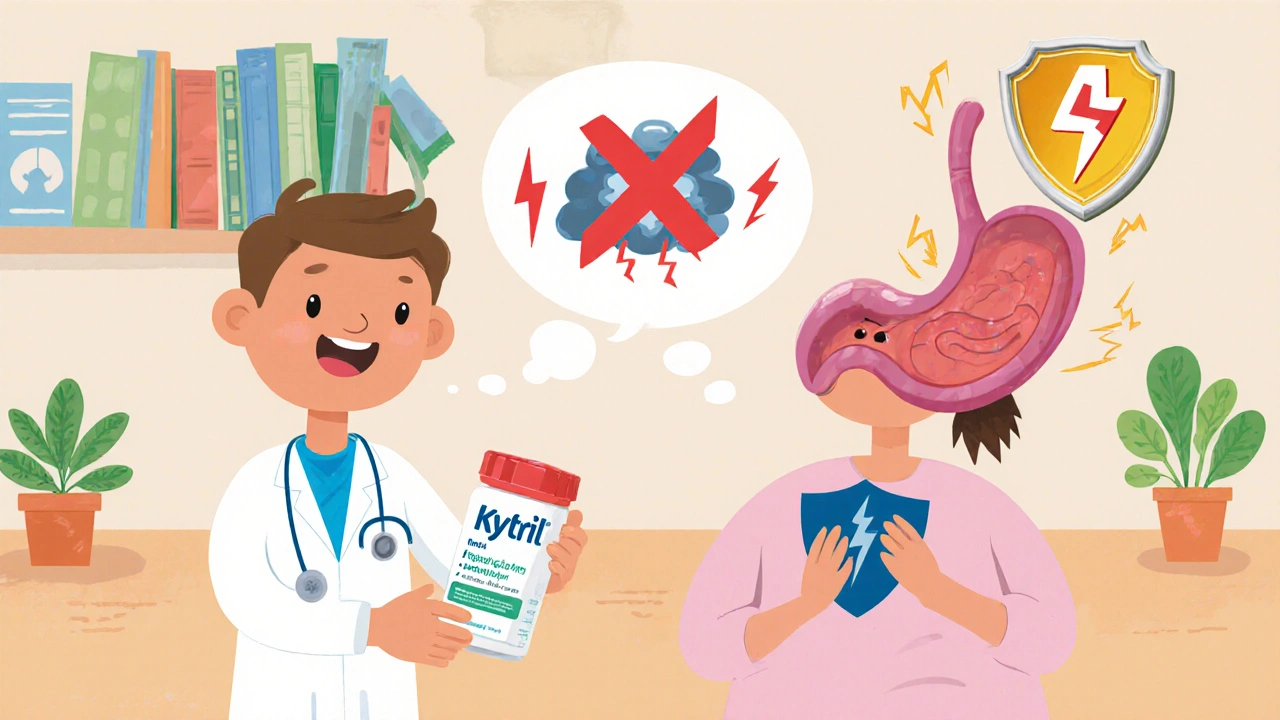Nausea Medication Selector
Find Your Best Antiemetic Option
Answer a few questions about your treatment to get personalized medication recommendations based on clinical guidelines.
Kytril (granisetron) has been a go-to option for preventing nausea and vomiting caused by chemotherapy, radiation, or surgery for decades. But it’s not the only player in the game. If you or someone you care about is dealing with severe nausea, you might be wondering: is Kytril still the best choice? Or are there newer, more effective, or cheaper alternatives out there?
What Kytril (Granisetron) Actually Does
Kytril is the brand name for granisetron, a drug that blocks serotonin - specifically the 5-HT3 receptors - in the brain and gut. These receptors get overstimulated during cancer treatments or after surgery, triggering vomiting. By blocking them, granisetron stops the signal before it reaches the vomiting center.
It comes in tablets, injections, and even a skin patch. Most people take it 30 to 60 minutes before chemotherapy starts. The effects last about 24 hours, which is why it’s often given once daily during chemo cycles. It works well for acute nausea - the kind that hits within the first 24 hours after treatment.
But here’s the catch: it doesn’t do much for delayed nausea, which can show up two to five days later. That’s where newer drugs step in.
Top Alternatives to Kytril
Several other antiemetic drugs are now commonly used alongside or instead of granisetron. Each has its own strengths and weaknesses.
Ondansetron (Zofran)
Ondansetron is probably the most well-known alternative to Kytril. Like granisetron, it blocks 5-HT3 receptors. In fact, they’re so similar that many doctors consider them interchangeable for acute nausea.
But there are differences. Ondansetron comes in more forms - including dissolvable tablets and oral solutions - which helps people who have trouble swallowing pills. It’s also slightly cheaper in many places, especially as a generic.
However, ondansetron has a bigger risk of causing QT prolongation - a heart rhythm issue - especially at higher doses. That’s why some hospitals limit its use in patients with existing heart conditions. Kytril doesn’t carry that same risk.
Aprepitant (Emend)
Aprepitant works differently. Instead of targeting serotonin, it blocks NK1 receptors in the brain. This makes it especially good for delayed nausea - the kind that shows up days after chemo.
Because of this, aprepitant is often combined with a 5-HT3 blocker like Kytril or ondansetron. In fact, the standard for high-risk chemo now is a three-drug combo: aprepitant + a 5-HT3 blocker + dexamethasone (a steroid). This combo cuts nausea in half compared to using just one drug.
The downside? Aprepitant is more expensive and comes with more side effects - fatigue, hiccups, and sometimes loss of appetite. It’s also a pill you take for three days straight, which can be hard to remember.
Fosaprepitant (Emend for Injection)
This is the IV version of aprepitant. It’s used when patients can’t take pills - maybe because they’re too nauseous or have a feeding tube. It gives the same benefits as oral aprepitant but in one shot. It’s more expensive than the pill, but for some, it’s the only practical option.
Palonosetron (Aloxi)
Palonosetron is a newer 5-HT3 blocker. Unlike Kytril and ondansetron, it sticks around in the body much longer - up to three days. That means it can cover both acute and delayed nausea with just one dose.
Studies show palonosetron is slightly more effective than granisetron at preventing delayed nausea. It’s often used for high-risk chemotherapy, like with cisplatin. The trade-off? It’s significantly more expensive. In Australia, a single dose of Aloxi can cost over $200, while Kytril tablets are under $30 with a PBS subsidy.
Dexamethasone
This steroid isn’t a direct replacement for Kytril, but it’s almost always used with it. Dexamethasone reduces inflammation and helps control nausea through a different pathway. It’s cheap, effective, and works well for both acute and delayed nausea.
But long-term use causes side effects - weight gain, mood swings, high blood sugar, and trouble sleeping. That’s why it’s usually only given for a few days during chemo cycles.
Comparison Table: Kytril vs. Alternatives
| Drug | Brand Name | Target | Duration | Best For | Key Risks | Cost (AUD, approx.) |
|---|---|---|---|---|---|---|
| Granisetron | Kytril | 5-HT3 | 24 hours | Acute nausea | Headache, constipation | $25-$35 (tablet, PBS) |
| Ondansetron | Zofran | 5-HT3 | 24 hours | Acute nausea, easy dosing | QT prolongation (high doses) | $20-$30 (generic) |
| Palonosetron | Aloxi | 5-HT3 | 3 days | Acute + delayed nausea | Headache, dizziness | $200+ (single dose) |
| Aprepitant | Emend | NK1 | 3 days | Delayed nausea (combined) | Hiccups, fatigue, drug interactions | $150-$250 (3-day course) |
| Fosaprepitant | Emend IV | NK1 | 3 days | Patients who can’t swallow pills | Same as aprepitant | $250-$350 (single IV) |
| Dexamethasone | Decadron | Multiple | 2-5 days | Combined therapy | Insomnia, mood changes, high blood sugar | $5-$10 (for 3 days) |

When to Choose Kytril Over Others
Kytril still has its place. If you’re on a budget and only need help with acute nausea, it’s a solid, reliable option. It’s especially good for people with heart conditions where ondansetron is risky. It’s also less likely to cause drowsiness than some older antiemetics like metoclopramide.
For low-risk chemo - like drugs that cause mild nausea - Kytril alone might be enough. Many clinics still use it as a first-line option because it’s been around so long, and doctors know exactly how it behaves.
When to Skip Kytril
Don’t rely on Kytril alone if you’re getting high-risk chemo - like cisplatin, doxorubicin, or cyclophosphamide. These drugs are notorious for causing delayed nausea, and Kytril won’t touch it.
If you’ve tried Kytril before and still got sick, it’s not a failure of willpower. It’s just not strong enough for your body’s response. That’s when you need a combo: palonosetron or aprepitant added in.
Also, if you’re taking other meds - especially those metabolized by the liver - aprepitant can interfere. Kytril doesn’t have many drug interactions, which makes it safer in complex medication regimens.
What Doctors Are Doing Now
In 2025, the standard of care for moderate-to-high risk chemotherapy is a three-drug combo: a 5-HT3 blocker (often palonosetron), aprepitant, and dexamethasone. This approach reduces nausea and vomiting by 70-80%, compared to 50-60% with older single-drug plans.
For low-risk chemo, single-agent Kytril or ondansetron is still common. But even then, many oncologists now add a low dose of dexamethasone just to be safe.
Palonosetron is gaining ground because it’s a one-and-done solution. One IV or pill covers the whole cycle. That’s a big win for patients who struggle with daily pills or who are traveling for treatment.

What You Should Ask Your Doctor
If you’re starting chemo and worried about nausea, don’t wait until you’re sick to bring it up. Ask these questions:
- What kind of chemo am I getting? Is it high-risk for delayed nausea?
- Is Kytril enough, or do I need a combo?
- Are there cheaper generic options that work just as well?
- Will I need to take pills for several days, or is there a single-dose option?
- Do I have any heart or liver conditions that might affect which drug is safest?
There’s no one-size-fits-all answer. Your best antiemetic depends on your treatment, your health, your budget, and your tolerance for side effects.
What’s New in 2025?
Two new drugs are entering the market: rolapitant and netupitant/palonosetron (Akynzeo). Rolapitant is another NK1 blocker with a longer half-life than aprepitant, meaning fewer doses. Akynzeo combines netupitant (an NK1 blocker) with palonosetron in one capsule - so you get two powerful drugs in a single pill.
These are still expensive and not always covered by PBS, but they’re becoming more common in private oncology clinics. For patients who’ve tried everything else and still get sick, they’re game-changers.
Bottom Line
Kytril isn’t outdated - but it’s no longer the whole story. For mild nausea, it’s still a good, affordable choice. For serious chemo, it’s just one piece of the puzzle. The best results come from matching the drug to the risk level of your treatment.
If you’re still getting nauseated despite taking Kytril, talk to your oncologist. There’s almost always a better combo out there. You don’t have to suffer through chemo with vomiting on top of it. The tools to stop it are here - you just need to ask for the right ones.
Is Kytril better than Zofran?
Kytril (granisetron) and Zofran (ondansetron) work the same way and are equally effective for acute nausea. Kytril has a lower risk of heart rhythm problems, so it’s often preferred for people with heart conditions. Zofran is cheaper and comes in more forms, like dissolvable tablets, which helps if swallowing is hard. Neither is outright better - it depends on your health and what’s available.
Can I take Kytril and aprepitant together?
Yes, and that’s actually the standard for high-risk chemotherapy. Kytril handles the first 24 hours of nausea, while aprepitant covers the delayed nausea that comes days later. Together, they’re much more effective than either alone. This combo is widely used in Australia and recommended by cancer guidelines.
Why is palonosetron more expensive than Kytril?
Palonosetron (Aloxi) is a newer drug with a longer duration - one dose lasts up to three days. That means fewer doses and better coverage for delayed nausea. The manufacturing process is more complex, and it’s still under patent protection in some markets. While Kytril is generic and cheap, Aloxi costs over $200 per dose in Australia, though PBS may cover part of it for certain patients.
Do I need steroids like dexamethasone with Kytril?
For moderate or high-risk chemo, yes. Dexamethasone boosts the effect of Kytril and helps with delayed nausea. For low-risk chemo, Kytril alone might be enough. But many doctors add a low dose of dexamethasone anyway because it’s cheap and improves outcomes. Talk to your oncologist - skipping it could mean more nausea later.
What if Kytril doesn’t work for me?
It doesn’t mean you’re doing something wrong. Some people just don’t respond to 5-HT3 blockers. The next step is adding an NK1 blocker like aprepitant or switching to palonosetron. In stubborn cases, newer drugs like netupitant/palonosetron (Akynzeo) or rolapitant may help. Don’t give up - there are options, and your team can adjust your plan.





13 Comments
Andrew Baggley
Kytril’s fine for mild stuff, but if you’re on cisplatin or doxorubicin and still throwing up? You’re doing it wrong. The combo of palonosetron + aprepitant + dexamethasone isn’t fancy-it’s standard. Stop treating nausea like it’s a minor inconvenience.
Frank Dahlmeyer
As someone who’s been through 3 rounds of chemo, I can tell you this: Kytril alone is like bringing a knife to a gunfight. My oncologist switched me to Aloxi after the first round-I didn’t vomit once the next time. Yeah, it costs more, but imagine not spending three days curled up in a fetal position. Worth every cent.
Codie Wagers
The fundamental flaw in this entire discourse is the implicit assumption that pharmaceutical efficacy is a function of molecular targeting alone. In reality, the pharmacokinetic variability between individuals-modulated by CYP3A4 polymorphisms, renal clearance, and blood-brain barrier permeability-renders blanket recommendations statistically invalid. Kytril is not ‘outdated’; it is merely contextually insufficient in high-emetic-risk regimens. The true metric of clinical superiority is not drug class, but patient-specific response entropy.
Paige Lund
So… we’re paying $200 for one pill so I don’t feel like I swallowed a grenade? Got it.
Reema Al-Zaheri
It is critical to note that the pharmacodynamic profile of palonosetron, with its extended half-life of approximately 40 hours, provides sustained 5-HT3 receptor antagonism, which is demonstrably superior to granisetron’s 7–9 hour half-life. Furthermore, the National Comprehensive Cancer Network (NCCN) guidelines, version 2.2025, explicitly endorse palonosetron-based regimens for high-emetic-risk chemotherapy, citing level 1A evidence. Cost should not override evidence-based practice.
Michael Salmon
Stop pretending Kytril is ‘affordable.’ It’s a relic. The fact that hospitals still use it is a testament to bureaucratic inertia, not clinical wisdom. If your oncologist is still prescribing Kytril alone for anything beyond low-risk chemo, find a new doctor. You’re being under-treated.
Joe Durham
I get that cost matters, and I get that some people respond better to one drug than another. But the real takeaway here is that nausea isn’t something you just ‘tough out.’ There are better tools now, and if you’re still suffering, it’s not your fault. Talk to your team. Ask about the combo. You deserve to feel better.
Derron Vanderpoel
OMG I JUST GOT MY FIRST DOSE OF ALOXI LAST WEEK AND I DIDN’T THROW UP ONCE FOR 3 DAYS?? I’M CRYING RN. I thought I was doomed to be sick every chemo day… thank you for writing this. I’m telling everyone.
Timothy Reed
For low-risk regimens like carboplatin or docetaxel, Kytril remains a viable, cost-effective option. However, for high-risk agents such as cisplatin or doxorubicin, the addition of dexamethasone and an NK1 antagonist is not optional-it is the standard of care. Clinicians must tailor therapy based on emetogenic risk stratification, not convenience or habit.
Christopher K
Why are we letting Big Pharma charge $200 for a pill? In America, you can’t even get a decent sandwich for that. Kytril works fine. If you can’t afford the fancy stuff, tough luck. Maybe you shouldn’t have gotten cancer.
harenee hanapi
Everyone’s so quick to say ‘just use the combo’-but have you ever tried to swallow three pills a day for a week while you’re nauseous? It’s impossible. And don’t get me started on how the nurses forget to give the IV. I’ve been through this five times. Nobody understands how hard it is to just… survive.
Christopher Robinson
❤️ This is so helpful. I’m a caregiver for my mom, and we’ve been using Kytril for her low-risk chemo. I didn’t realize how much better things could be with the combo. We’re going to ask about Aloxi next round. Thank you for breaking it down so clearly. 🙏
seamus moginie
It is a matter of profound moral failure that a life-saving intervention such as palonosetron remains financially inaccessible to a majority of the global population. The disparity between the efficacy of modern antiemetics and their cost is not a market failure-it is a systemic betrayal of human dignity. We must demand universal access to evidence-based care, regardless of geography or income. Kytril may be cheap, but suffering is not a commodity to be rationed.